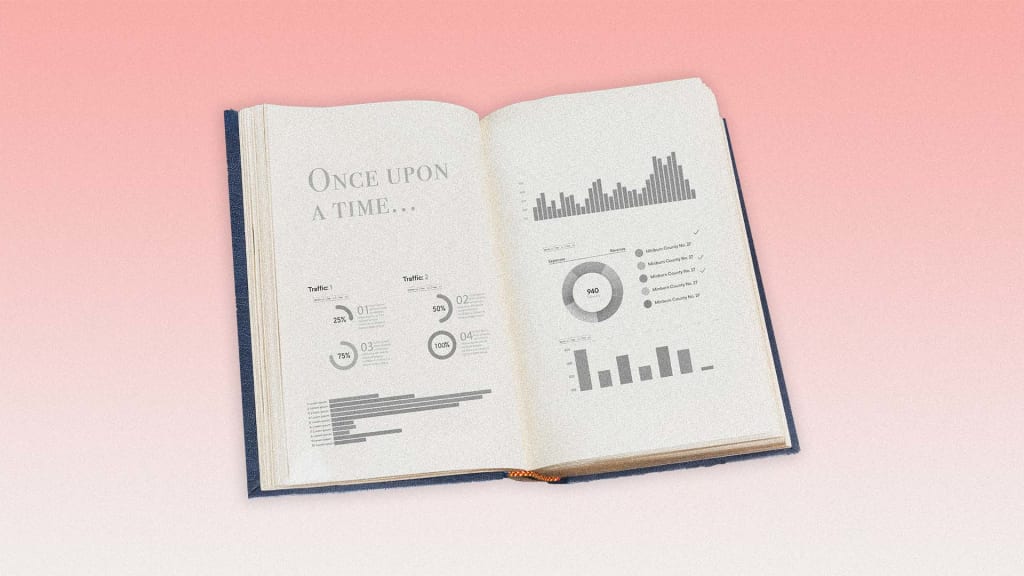
I love a good story whether it's a book, a movie or a TED Talk. Stories can be enlightening or moving. But there's nothing quite like stories with a stickiness factor where I often think about and return to what I've learned from it.
On the other hand, have you ever been to a presentation rich in data but short on a narrative? There's no story, nothing compelling to help you connect the data to the larger insights and you find yourself struggling to discern what the presenter is attempting to convey. The audience's eyes collectively begin to gloss over as they make an effort to remain present. But the reality is, absent an accompanying story, data can be painfully boring.
Storytelling is an art form and is an incredibly important communication tool that gives the audience more context. A narrative plus data paints a picture so that the appropriate contextualization is shared and the full story can be understood.
Below are a few ideas to help ensure the story is always part of the messaging process:
1. Start with a story.
Simply put, the story is the stickiness that frames the communication. Politicians use storytelling all the time. They'll tell a story about Casey, the writer, whose life was improved because of a piece of legislation. As the listener, you may not know what the legislation does, but you may remember what it did for Casey.
That's why stories are so important-- it ties everything all together. Descriptors like people, pictures, colors, sounds, and points of view drive the point home and help you understand what that data means. Without those added elements, what is being shared may not be fully understood or appreciated.
Consider starting with an overview or executive summary so that the reader knows where you're taking them from the onset. Adding visuals help too, they can help bring the story to life.
2. Make the data entertaining.
Data is just information. It has to be interpreted and ordered so it's not confusing. It needs to be organized, distilled, and decoded so the audience knows what the message is and the associated actions that can be taken. Crafting a story gives data a voice and makes it a feature instead of a footnote.
Consider framing your data in an amusing or comedic way. Comedians are some of the best storytellers-- they share data, facts, build a story and deliver a punchline. Not only do you laugh, you remember the element of the joke including the data.
3. Put things into context.
People are bombarded with information all day, whether through emails, social media, conversations, books or magazines. There are so many sources and, at times, very little context. Stories with data and moreover context allows us to see into other perspectives different from our own. Stories when coupled with context and data make things relatable and memorable.
I use data plus stories, anecdotes, and colloquialisms to help illustrate my points and to most importantly, connect with my audience. It has helped immensely in my career to tap into a collective spirit that connects rather than divides. Too often, we forget about the power of storytelling when conveying our messages.
4. Craft connection.
People yearn for connection. With data and an effective story, people can better see the data because they are connected to it. Tapping into those connective strands of being relatable helps the data become the supporting actor in the larger production of the story. If the audience feels connected to the story, they'll be connected to the data and more likely to act.
The best presentations have an idea, a story, a personal narrative, data, and visuals. Each element strengthens the connection and effectively pulls you in.
5. Know your audience
The type of story matters depends on your audience. As a presenter, one needs to be able to move from one topic to another seamlessly as some groups need more granular information, while others just need the highlights. For instance, if you are presenting to the Board, telling a story about Casey may not be the best approach but telling a story about how the customers are impacted is compelling. The data drives and the story should deliver at the right altitude.
More information doesn't necessarily improve judgment. Bias and preconceived notions are inherently human. The quality of decision-making can degrade with more information because it activates, at times, our base beliefs and masks our true feelings. Everyone is biased and introducing more information likely won't change beliefs or attitudes, but stories can and do. An effectively told story can change the tone and tenor of the audience.
"story" - Google News
February 20, 2022 at 06:53PM
https://ift.tt/lGZ6PB8
How to Tell a Good Story with Data - Inc.
"story" - Google News
https://ift.tt/dQv3fub
https://ift.tt/cTk0NUl
Bagikan Berita Ini














0 Response to "How to Tell a Good Story with Data - Inc."
Post a Comment